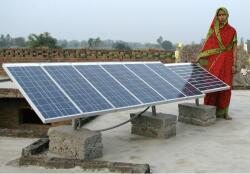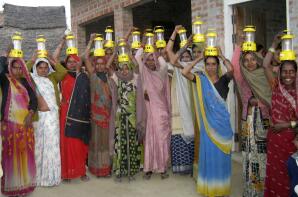Better than a Bake Sale
Sure solar power is great, but how do you raise the funds needed for all the fancy equipment? That was a question that Aaron Sebens' fourth grade class had no problem answering. This tech-savvy group of North Carolina kids used the online crowd funding platform Kickstarter to raise money to get their classroom off the grid.
As reported in Treehugger.com, the class raised $2,700 for their project. Before beginning fundraising, the fourth graders had first figured out how much electricity they consumed, how many solar panels would be needed, and the cost. Their initial plan was to raise only $800, but they quickly surpassed that. "The more we raise," said Sebens, "the more panels we'll be able to buy to sell clean electricity to our community! If we can raise $3000 we'll be able to make almost 1kw of clean energy for the grid."
Too Big, Too Dumb
How is it that a bunch of fourth graders can raise needed capital for a solar project but major banks are having a difficult time of it? In a recent New York Times article, Rabobank Executive Vice President, Marco Krapels said, "only a small number of U.S. banks are involved in financing solar projects. Many lack the expertise to evaluate the risks; others have little interest in modest power projects."
Major banks are dragging their feet; meanwhile, "modest" solar power projects like that of Mr. Sebens' class are being crowd funded worldwide. In January, Oakland, California-based Mosaic introduced a crowd funding platform that makes it possible for small, non-accredited investors to earn interest by financing clean energy projects. When Mosaic posted its first four investments online (solar projects offering 4.5 percent returns to investors who could participate with loans as small as $25), more than 400 people had invested on the first day and the projects sold out.
This instant momentum speaks to the fundamental crowd sourcing ethos, which is: let everyone participate in the solution and they will get more engaged.
What is crowd funding? Essentially it is a grassroots group of individuals who network and pool their money to support efforts originated by others. Crowd funding is used to support a wide variety of activities from disaster relief, art projects, and invention development to scientific research and civic projects. Crowd funding also refers to a company raising capital by selling small amounts of equity to many investors. This type of crowd funding is being included in the recently passed JOBS Act legislation that allows for a wider pool of small investors with fewer restrictions.
 Solar in the Developing World
Solar in the Developing World
In the developing world, solar power is vital for economic, health and environmental reasons. Those who do not have electricity pay far more for their energy needs by buying kerosene and candles than they would for solar energy. Over a decade, a poor family may spend $1,800 on these energy sources -- five or six times what it would take to install a home solar system that could power lights that would be cheaper and safer.
 Humana People to People India (HPPI) has worked with the U.S. Agency for International Development on the project Community Development with Solar Illumination. This project promotes the development and utilization of renewable energy through solar devices and services among rural villages (serving about 30-35,000 people). Providing quality solar illumination in homes enables children to study in the evening and offers a smoke-free indoor home environment for work done at night. Through the installation of solar panels and use of lanterns in each of the villages, the project helps to expand renewable energy. To read more about this and other projects see our India page or visit HPPI.
Humana People to People India (HPPI) has worked with the U.S. Agency for International Development on the project Community Development with Solar Illumination. This project promotes the development and utilization of renewable energy through solar devices and services among rural villages (serving about 30-35,000 people). Providing quality solar illumination in homes enables children to study in the evening and offers a smoke-free indoor home environment for work done at night. Through the installation of solar panels and use of lanterns in each of the villages, the project helps to expand renewable energy. To read more about this and other projects see our India page or visit HPPI.
